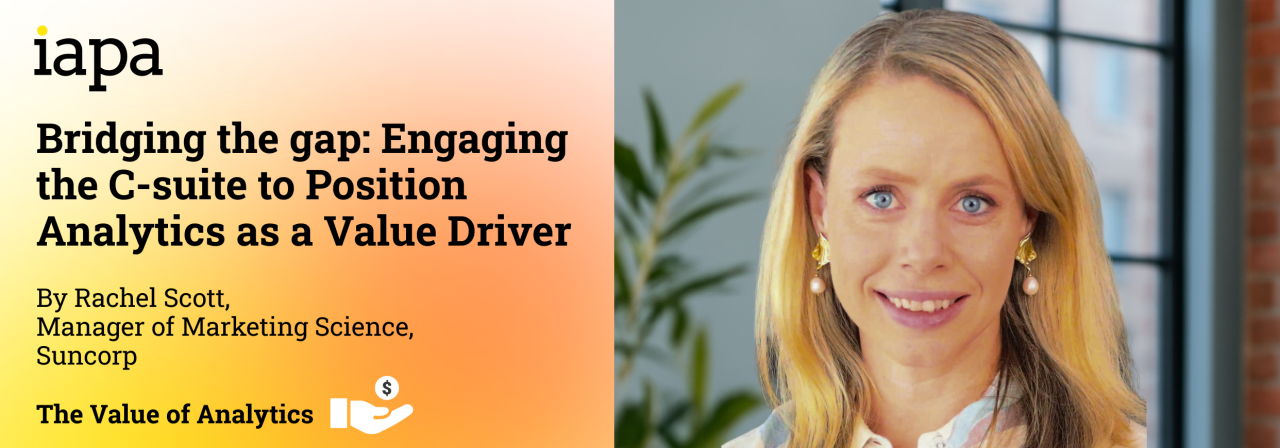
Bridging the gap: Engaging the C-suite to position analytics as a value driver
By Rachel Scott, Manager, Marketing Science, Suncorp
Analytics has the potential to be a strategic enabler – but realising the value of a data‑driven business requires engaging the C-suite and finance leaders to connect analytical insights with business outcomes. Many organisations invest in advanced analytics, yet translating the insights into commercial language remains a challenge. As a marketing science leader, I have experienced both success stories and learning opportunities while leaning into this challenge first-hand. Unless analytical insights are communicated in business terms and connected to strategic outcomes, the power of data-driven insight can go unseen. By speaking in the language of finance, we can bridge the gap between decision-makers and data teams to position analytics as a value driver.
The Challenge of Cross-Functional Engagement
The sophistication of analytical practices is growing, enabled by big data and now the rise of AI. However, I see regularly, analytic professionals focused on building their technical strengths without prioritising their need to grow financial literacy or business acumen.
At the executive table, success is measured through revenue and profit growth. If our analytics insights aren’t explicitly linked to metrics that matter to our leaders, then our recommendations will not gain attention. Even brilliant work can fail to drive action if it is communicated in a complex way or through irrelevant metrics.
Find a Common Language for Value Contribution
The first step to engaging executive leadership is to frame insights in the context of the organisation’s strategic goals, with metrics aligned to financial contribution. Translating analytics into finance-friendly language builds credibility and gives comparative weighting against other business initiatives.
In one case, my team developed a communication framework for Return on Marketing Investment to align the long-term value of brand marketing. By presenting insights in terms of incremental revenue and cost-efficiency gains, we secured buy-in from finance to fund further value-driving marketing activities.
In another case, we introduced advanced modelling to optimise media investment (Market Mix Modelling). Rather than diving into methodology or model coefficients, we shaped our stakeholder communication around outcomes such as uplifts in revenue due to marketing effectiveness or efficiency improvements. By positioning marketing as a value driver through finance-aligned measurement, we have driven consistent year on year incremental investment.
Value Is Realised When Insights Are Actioned
One practical strategy to ensuring decisions are made using analytical insight, is to embed analytics leaders into existing decision-making forums. Value is lost in the hand-off of insights, so bringing analytics leaders into the conversations where strategic decisions are made will reduce risk and enhance the quality of decisions.
In my organisation, my team have set up monthly workshops where analytical insights are workshopped directly with decision makers. We build a cross-functional dialogue about implications and next steps to ensure that all stakeholders participate in the generation of the insight. Together, we can ask questions, challenge assumptions and feel collective ownership of the translation of insight into action.
Another way to build adoption of insights to realise business value, is to ensure your team is designed to connect analytics to business domains. For example, having a dedicated role or explicit process step to act as an ‘analytics translator’ is a critical bridge between data scientists and business leaders. This important role or process combines domain knowledge with advanced analytical savvy to make sure the solutions solve real business problems and results are communicated in impactful ways.
Build trust by measuring the impact of actioned insights. A few high-profile wins can go a long way to positioning analytics as a value-add function.
Barriers and Enablers to Realising the Value of Analytics
Barrier to Engagement |
Enabler or Solution |
Analytics presented in technical terms |
Translate insights into business outcomes. Focus on the “so what?” – e.g. impact on profit or strategy, not the technical details. |
Unclear ROI or business value attribution |
Implement value measurement frameworks to quantify impact. Share case studies that quantify wins. |
Lack of trust or understanding of analytical methods |
Increase transparency and involvement. Use analytics translators to bridge technical and business knowledge. |
Analytics is siloed from strategic planning |
Embed analytics into decision processes. Integrate data analysis into annual planning and budgeting. |
Skills gap in communication and business acumen |
Upskill analytics teams in financial literacy and storytelling. Improve data literacy among decision makers. |
The Competitive Advantage
Analytics professionals and data scientists must see themselves as strategic influencers, not just as reporting the numbers. Likewise, senior executives can make better decisions when championing an evidence-based performance culture. When business leaders ask analytic-informed questions, it sets the tone for the organisation to follow.
The competitive edge will be gained by those companies that integrate analytics into decision making across all levels of leadership. Not just by staying at the forefront of AI, but through actioning insights built on trust, communication and collaboration.
About the author
Rachel Scott is Manager of Marketing Science at Suncorp, where she leads a team of analytics professionals focused on connecting marketing performance with business outcomes. She was recognised in the Top 10 Analytics Leaders in Australia (IAPA & B&T) and is a regular contributor to industry thought leadership on marketing effectiveness, econometrics, and strategic analytics.
